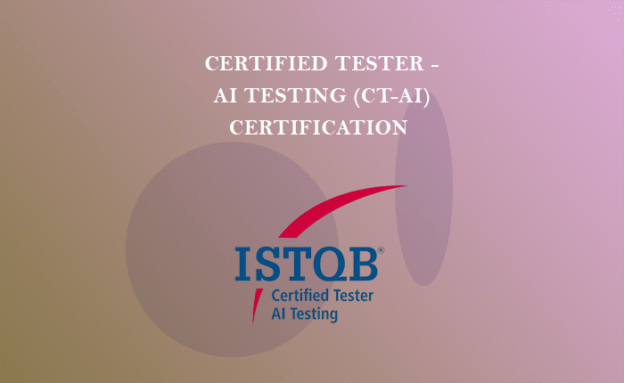Certified Tester – AI Testing (CT-AI) Training

About Course
Certified Tester – AI Testing (CT-AI) Training is a specialized program designed to equip software testers and QA professionals with the skills required to test artificial intelligence systems effectively. The training covers key concepts such as AI fundamentals, machine learning workflows, quality attributes, risks, biases, and testing strategies unique to AI-driven applications. It emphasizes real-world techniques for validating data, models, and AI system behavior using structured test approaches. Participants learn to evaluate transparency, robustness, fairness, and performance of AI solutions. CT-AI certification enhances a tester’s capability to ensure reliable, ethical, and high-quality AI systems across diverse industries.
What Will You Learn?
- 1. Career Advancement
- 2. Expertise Validation
- 3. In-Demand Skills
- 4. Global Recognition
- 5. Access to Resources
- 6. Customization Mastery
- 7. Job Security
Course Content
One On One Training
Module 1- Introduction
-
1.1 Purpose of this Syllabus
-
1.2 The Certified Tester AI Testing
-
1.3 Examinable Learning Objectives and Cognitive Level of Knowledge
-
1.4 Hands-on Levels of Competency
-
1.5 The Certified Tester AI Testing Exam
-
1.6 Accreditation
-
1.7 Level of Detail
-
1.8 How this Syllabus is Organized
Module 2 – Introduction to AI
-
2.1 Definition of AI and AI Effect
-
2.2 Narrow, General and Super AI
-
2.3 AI-Based and Conventional Systems
-
2.4 AI Technologies
-
2.5 AI Development Frameworks
-
2.6 Hardware for AI-Based Systems
-
2.7 AI as a Service (AIaaS)
-
2.8 Pre-Trained Models
-
2.9 Standards, Regulations and AI
Module 3- Quality Characteristics for AI-Based Systems
-
3.1 Flexibility and Adaptability
-
3.2 Autonomy
-
3.3 Evolution
-
3.4 Bias
-
3.5 Ethics
-
3.6 Side Effects and Reward Hacking
-
3.7 Transparency, Interpretability and Explainability
-
3.8 Safety and AI
Module 4- Machine Learning (ML) – Overview
-
4.1 Forms of ML
-
4.2 ML Workflow
-
4.3 Selecting a Form of ML
-
4.4 Factors Involved in ML Algorithm Selection
-
4.5 Overfitting and Underfitting
-
4.6 ML – Data – 230 minutes
-
4.7 Data Preparation as Part of the ML Workflow
-
4.8 Training, Validation and Test Datasets in the ML Workflow
-
4.9 Dataset Quality Issues
-
4.10 Data Quality and its Effect on the ML Model
-
4.11 Data Labelling for Supervised Learning
Module 5- ML Functional Performance Metrics
-
5.1 Confusion Matrix
-
5.2 Additional ML Functional Performance Metrics for Classification,Regression and Clustering
-
5.3 Limitations of ML Functional Performance Metrics
-
5.4 Selecting ML Functional Performance Metrics
-
5.5 Benchmark Suites for ML
Module 6- ML – Neural Networks and Testing
-
6.1 Neural Networks
-
6.2 Coverage Measures for Neural Networks
Module 7- Testing AI-Based Systems Overview
-
7.1 Specification of AI-Based Systems
-
7.2 Test Levels for AI-Based Systems
-
7.3 Test Data for Testing AI-based Systems
-
7.4 Testing for Automation Bias in AI-Based
-
7.5 Documenting an AI Component
-
7.6 Testing for Concept Drift
-
7.7 Selecting a Test Approach for an ML System
Module 8- Testing AI-Specific Quality
-
8.1 Challenges Testing Self-Learning Systems
-
8.2 Testing Autonomous AI-Based Systems
-
8.3 Testing for Algorithmic, Sample and Inappropriate Bias
-
8.4 Challenges Testing Probabilistic and Non-Deterministic AI-Based Systems
-
8.5 Challenges Testing Complex AI-Based Systems
-
8.6 Testing the Transparency, Interpretability and Explainability of AI-Based Systems
-
8.7 Test Oracles for AI-Based Systems
-
8.8 Test Objectives and Acceptance Criteria
Module 9- Methods and Techniques for the Testing of AI-Based Systems
-
9.1 Adversarial Attacks and Data Poisoning
-
9.2 Pairwise Testing
-
9.3 Back-to-Back Testing
-
9.4 A/B Testing
-
9.5 Metamorphic Testing (MT)
-
9.6 Experience-Based Testing of AI-Based Systems
-
9.7 Selecting Test Techniques for AI-Based Systems
Module10- Test Environments for AI-Based Systems
-
10.1 Test Environments for AI-Based Systems
-
10.2 Virtual Test Environments for Testing AI-Based Systems
Module11- Using AI for Testing
-
11.1 AI Technologies for Testing
-
11.2 Using AI to Analyze Reported Defects
-
11.3 Using AI for Test Case Generation
-
11.4 Using AI for the Optimization of Regression Test Suites
-
11.5 Using AI for Defect Prediction
-
11.6 Using AI for Testing User Interfaces
